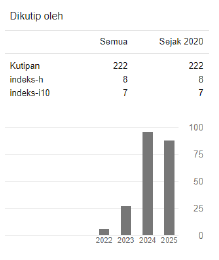Utilisation of Augmented Reality (AR) and Virtual Reality (VR) in Education: A Systematic Review
 https://doi.org/10.54012/ijcer.v4i1.623
https://doi.org/10.54012/ijcer.v4i1.623
 Abstract views: 159
Abstract views: 159
 PDF downloads: 172
PDF downloads: 172
Keywords:
Augmented Reality, Virtual Reality, Educational Technology, Systematic ReviewAbstract
This review systematically examined the effectiveness and challenges of utilising Augmented Reality (AR) and Virtual Reality (VR) technologies in the field of education over the past decade. As immersive technologies developed, AR and VR offered new approaches that were interactive, contextual, and constructivist in the teaching and learning process. This study employed a systematic review method based on the PRISMA protocol to analyse 60 scholarly articles published between 2015 and 2025, covering various educational levels, fields of study, and learning outcome indicators. The findings revealed that the application of AR and VR generally enhanced conceptual understanding, motivation, student engagement, and psychomotor skills, particularly within the contexts of science, engineering, medical education, and vocational training. Nevertheless, the implementation of these technologies still faced several obstacles, including infrastructure limitations, teacher preparedness, and potential psychological effects such as disorientation and cybersickness. The review also highlighted a growing trend of collaboration between educational institutions and technology industries in the development of AR/VR content, as well as the importance of policy support in expanding access to and the quality of immersive technology-based learning. Thus, AR and VR held significant potential as integral components in the transformation of future educational ecosystems, provided they were accompanied by appropriate pedagogical strategies and adequate readiness of supporting ecosystems.
Downloads
References
M. Billinghurst, A. Clark, and G. Lee, “A survey of augmented reality,” Foundations and Trends in Human–Computer Interaction, vol. 8, no. 2–3, pp. 73–272, 2014.
K.-H. Cheng and C.-C. Tsai, “Affordances of augmented reality in science learning: Suggestions for future research,” Journal of Science Education and Technology, vol. 22, pp. 449–462, 2013.
J. Radianti, T. A. Majchrzak, J. Fromm, and I. J. Wohlgenannt, “A systematic review of immersive virtual reality applications for higher education: Design elements, lessons learned, and research agenda,” Computers & Education, vol. 147, 103778, 2020.
D. Fonseca, E. Redondo, M. Villagrasa, “Mixed-methods research: A new approach to evaluating the motivation and satisfaction of university students using advanced visual technologies,” Universal Access in the Information Society, vol. 14, pp. 311–332, 2015.
N. Gavish et al., “Evaluating virtual reality and augmented reality training for industrial maintenance and assembly tasks,” Interactive Learning Environments, vol. 23, no. 6, pp. 778–798, 2015.
D. R. Bressler and A. M. Bodzin, “A mixed methods assessment of students’ flow experiences during a mobile augmented reality science game,” Journal of Computer Assisted Learning, vol. 29, pp. 505–517, 2013.
M. Barreda-Angeles and T. Hartmann, “Psychological effects of immersive storytelling in 360-degree video and virtual reality,” Media Psychology, vol. 22, no. 3, pp. 393–418, 2019.
R. Pottle, “Virtual reality and the transformation of medical education,” Future Healthcare Journal, vol. 6, no. 3, pp. 181–185, 2019.
M. A. Al Zayer, A. J. Williams, and R. S. Dyer, “An evaluation of flight training using immersive virtual reality,” Journal of Aviation Technology and Engineering, vol. 9, no. 2, pp. 1–12, 2020.
A. W. N. Wong, C. H. T. Li, and H. K. Lee, “The use of augmented reality in training field technicians: A case study,” Procedia Computer Science, vol. 75, pp. 1–8, 2015.
G. Akçayır and M. Akçayır, “Advantages and challenges associated with augmented reality for education: A systematic review of the literature,” Educational Research Review, vol. 20, pp. 1–11, 2017.
M. D. Wiederhold, “Virtual reality and mental health: The next wave of therapeutic tools,” Cyberpsychology, Behavior, and Social Networking, vol. 23, no. 3, pp. 183–184, 2020.
M. D. Wiederhold and B. K. Riva, “Virtual reality therapy: Emerging topics and future challenges,” Cyberpsychology, Behavior, and Social Networking, vol. 22, no. 1, pp. 3–6, 2019.
J. Garzón and J. Acevedo, “Meta-analysis of the impact of augmented reality on students’ learning gains,” Educational Research Review, vol. 27, pp. 244–260, 2019.
D. Hamilton, M. McKechnie, A. Edgerton, and S. Wilson, “Immersive virtual reality as a pedagogical tool in education: A systematic literature review of quantitative learning outcomes,” Journal of Computers in Education, vol. 8, pp. 1–32, 2021.
H.-M. Huang, S.-S. Liaw, and H.-F. Lai, “Exploring learner acceptance of the use of virtual reality in medical education: A case study of desktop and projection-based display systems,” Interactive Learning Environments, vol. 24, no. 1, pp. 3–19, 2016.
R. Lindgren et al., “Enhancing learning and engagement through embodied interaction within a mixed reality simulation,” Computers & Education, vol. 95, pp. 174–187, 2016.
D. C. Richards and J. Taylor, “A comparison of virtual reality and 2D desktop environments for learning about spatial relationships,” Computers & Education, vol. 113, pp. 1–15, 2017.
M. B. Nincarean, M. Alia, M. N. Zaid, and N. S. N. Rahman, “Mobile augmented reality: The potential for education,” Procedia - Social and Behavioral Sciences, vol. 103, pp. 657–664, 2013.
I. Radu, “Augmented reality in education: A meta-review and cross-media analysis,” Personal and Ubiquitous Computing, vol. 18, no. 6, pp. 1533–1543, 2014.
A. D. Dunleavy, C. Dede, and R. Mitchell, “Affordances and limitations of immersive participatory augmented reality simulations for teaching and learning,” Journal of Science Education and Technology, vol. 18, no. 1, pp. 7–22, 2009.
UNESCO, “Education and digital technologies: Towards equitable learning opportunities for all,” UNESCO Report on Digital Learning, Paris, France, 2021.
Google, “Google Expeditions,” [Online]. Available: https://edu.google.com/products/vr-ar/expeditions. [Accessed: 10-Apr-2025].
CoSpaces Edu, “Create. Explore. Experience. Learn,” [Online]. Available: https://cospaces.io/edu. [Accessed: 10-Apr-2025].
M. Teräs, M. Suoranta, H. Teräs, and J. Curcher, “Post-Covid-19 education and education technology ‘solutionism’: A seller’s market,” Postdigital Science and Education, vol. 2, pp. 863–878, 2020.
D. Moher et al., “Preferred reporting items for systematic reviews and meta-analyses: The PRISMA statement,” PLoS Medicine, vol. 6, no. 7, e1000097, 2009.
P. Rethlefsen et al., “PRISMA-S: An extension to the PRISMA Statement for reporting literature searches in systematic reviews,” Systematic Reviews, vol. 10, 39, 2021.
A. P. Siddaway, A. M. Wood, and L. V. Hedges, “How to do a systematic review: A best practice guide for conducting and reporting narrative reviews, meta-analyses, and meta-syntheses,” Annual Review of Psychology, vol. 70, pp. 747–770, 2019.
V. Braun and V. Clarke, “Using thematic analysis in psychology,” Qualitative Research in Psychology, vol. 3, no. 2, pp. 77–101, 2006.
CASP, “Critical Appraisal Skills Programme (CASP) checklists,” [Online]. Available: https://casp-uk.net/casp-tools-checklists/. [Accessed: 10-Apr-2025].
A. Paez, “Gray literature: An important resource in systematic reviews,” Journal of Evidence-Based Medicine, vol. 10, no. 3, pp. 233–240, 2017.
M. J. Page et al., “PRISMA 2020 explanation and elaboration: Updated guidance and exemplars for reporting systematic reviews,” BMJ, vol. 372, n160, 2021.
Downloads
Published
How to Cite
Issue
Section
License
Copyright (c) 2025 Adelina Anum, Sigit Apriyanto

This work is licensed under a Creative Commons Attribution-ShareAlike 4.0 International License.









